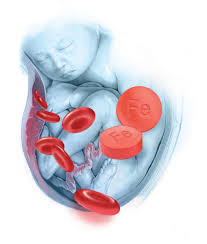CAUSES OF ANEMIA IN PREGNANCY
Anemia is one of the most frequent complications related to pregnancy. The word implies a decrease in the oxygen-carrying capacity of the blood and is best characterized by a reduction in hemoglobin concentration.
Because of the normal physiologic changes in pregnancy that affect the hematocrit and certain other parameters, such as hemoglobin, reticulocytes, plasma ferritin, and unsaturated iron-binding capacity, diagnosing true anemia, as well as determining the etiology of anemia, is challenging. The most common anemias are iron-deficiency anemia and folate deficiency megaloblastic anemia. These anemias are more common in women who have inadequate diets and who are not receiving prenatal iron and folate supplements. Other less common causes of acquired anemia in pregnancy are aplastic anemia and hemolytic anemia. In addition, anemias such as thalassemia and sickle cell disease can have an impact on the health of the mother and fetus.
As was stated above, the most frequent causes of true or absolute anemia are nutritional deficiencies. Frequently, these deficiencies are multiple, and the clinical presentation may be complicated by attendant infections, generally poor nutrition, or hereditary disorders such as hemoglobinopathies. However, the fundamental sources of nutritional anemia embody insufficient intake, inadequate absorption, increased losses, expanded requirements, parasitic infestations, and insufficient utilization of hemopoietic nutrients.
Approximately 75% of all anemias diagnosed during pregnancy are due to iron deficiency. A significant deficiency of iron leads to characteristic hypochromic, microcytic erythrocytes on the peripheral blood smear. Other causes of hypochromic anemias, even rare, must be considered, including hemoglobinopathies, inflammatory processes, chemical toxicity, malignancy, and pyridoxine-responsive anemia. However, the greater percentage of the remaining cases of anemia in pregnancy other than the iron-deficiency type consists of the megaloblastic anemia of pregnancy due to folic acid deficiency and, to a lesser extent, to vitamin B12 deficiency. Anemia caused by deficiencies of other vitamins or elements does not commonly occur in humans.

Nutritional anemia is not a broad-based problem in the populations of developed countries. It is nevertheless a problem for many individuals in these countries, and it is certainly a major health problem in poor, underdeveloped countries. Pregnant women, as well as menstruating women and children, make up the segment of the population in third-world countries—and even in the United States and Europe— that is affected by nutritional deficiency, sometimes accompanied by frank anemia. In conclusion, the investigation of acquired anemias during pregnancy is very important, considering that inadequate nutrition and nutritional deficiencies have an adverse impact on pregnancy outcome, without excluding a priori other, less common types of anemia.
Medigrad is offering a 1-Year “Fellowship in Gynecology & Obstetrics” which covers the in-depth knowledge about the Anemia in Pregnancy, Classification, Maternal &Fetal Consequences, Clinical Signs and Symptoms, Diet, and necessary preventions. The program is very well researched and curated by a senior panel of doctors having in-depth knowledge and vast experience into Gynecology & Obstetrics. The course is delivered in the blended format (Online and Practical Learning) and is majorly for young doctors who have a keen interest in Gyne & Obs and want to upgrade their knowledge and enhance their skills into the same. It would be a great learning experience for the doctors who have completed their MBBS and are looking for online courses after MBBS since the blended programs offered by Medigrad are specially designed for young doctors, written and curated by a senior panel of highly experienced doctors.
